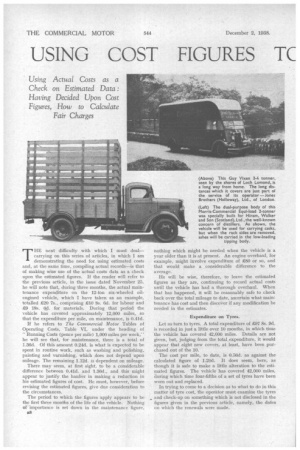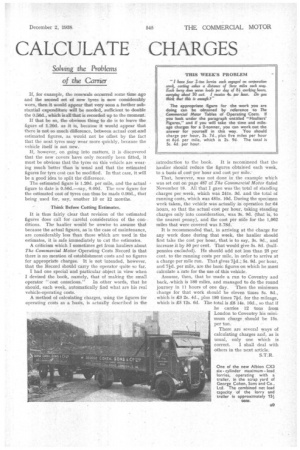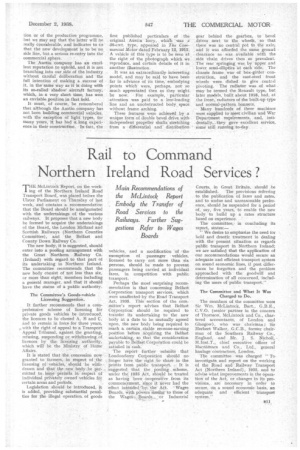USING COST FIGURES TC CALCULATE CHARGES
Page 42

Page 43

Page 45

If you've noticed an error in this article please click here to report it so we can fix it.
THE next difficulty with which I must deal— carrying on this series of articles, in which I am demonstrating the need for using estimated costs and, at the same time, compiling actual records—is that of making wise use of the actual costs data as a check upon the estimated figures. If the reader will refer to the previous article, in the issue dated November 25, he will note that, during three months, the actual maintenance expenditure on the 12-ton six-wheeled oilengined vehicle, which I have taken as an example, , totalled 220 7s., comprising 210 8s. 6d, for labour and 29 18s. 61. for materials. During that period the vehicle has covered approximately 12,000 miles, so that the expenditure per mile, on maintenance, is 0.41d.
If he refers to The Commercial Motor Tables of Operating Costs, Table VI, under the heading . of Running Costs (pence per mile) 1,000 miles per week," he will see that, for maintenance, there is a total of 1.36d. Of this amount 0.24d, is what is expected to be spent in routine work, such as washing and polishing, painting and varnishing, which does not depend upon mileage. The remaining I.12d. is dependent on mileage.
There may seem, at first sight, to be a considerable difference between 0.41d. and 1.36d., and this might appear to justify the haulier in making a reduction in his estimated figures of cost. He must, however, before revising the estimated figures, give due consideration to the circumstances.
The period to which the figures apply appears to be the first three months of the life of the vehicle. Nothing of importance is set down in the maintenance figure, a8
nothing which might be needed when the vehicle is a year older than it is at present. An engine overhaul, for example, might involve expenditure of 280 or so, and
that would make a considerable difference to the average.
He will be wise, therefore, to leave the estimated figures as they are, continuing to record actual costs until the vehicle has had a thorough overhaul. When that has happened, it will be reasonably safe to check back over the total mileage to date, ascertain what main“ tenance has cost and then discover if any modification be needed in the estimates.
Expenditure on Tyres.
Let us turn to tyres. A total expenditure of .297 8s. 91L
is recorded in just a little over 10 months, in which time the vehicle has covered 42,000 miles. Details are not given, but, judging from the total expenditure, it would appear that eight new covers, at least, have been pur
chased out of the 10.
The cost per mile, to date, is 0.56d, as against the calculated figure of 1.20d. It does seem, here, as though it is safe to make a little alteration to the esti mated figures. The vehicle has covered 42,000 miles, during which time four-fifths of a set of tyres have been worn out and replaced.
In trying to come to a decision as to what to do in this matter of tyre cost, the operator must examine the tyres and check-up on something which is not disclosed in the figures given in the previous article, namely, the dates on which the renewals were made. If, for example, the renewals acctured some time ago and the second set of new -tyres is now considerably worn, then it would appear that very soon a further substantial expenditure will be needed., sufficient to double the 0.56d., which is all that is recorded up to the moment.
If that be so, the obvious thing to do is to leave the figure of 1.20d. as it is, because it would appear that there is not so much difference, between actual cost and estimated figures, as would not be offset by the fact that the next tyres may wear more quickly, because the vehicle itself is not new.
If, however, on going into matters, it is discovered that the new covers have only recently been fitted, it must be obvious that the tyres on this vehicle are wearing much better than is usual and that the estimated figures for tyre cost can be modified. In that case, it will be a good idea to split the difference.
The estimated figure is 1.20d. per mile, and the actual figure to date is 0.56c1.—say, 0.60d. The new figure for the estimated cost of tyres can thus be made 0.90d., that being used for, say, another 10 or 12 months.
Think Before Cutting Estimates.
It is thus fairly clear that revision of the estimated figures does call for careful consideration of the conditions. The haulier would be unwise to assume that because the actual figures, as in the case of maintenance, are considerably less than those which are used in the estimates, it is safe immediately to cut the estimates.
A criticism which I sometimes get from hauliers about The Commercial Motor Operating Costs Record is that there is no mention of establishment costs and no figures for appropriate charges. It is not intended, however, that the Record should carry the operator quite so far.
I had one special and particular object in view when I devised the book, namely, that of -making the small operator "cost conscious." In other words, that he should, each week, automatically find what are his real vehicle-operating costs.
A method of calculating charges, using the figures for operating costs as a basis, is actually described in the
introduction to the book. It is recomlnend that the
haulier should reduce the figures obtained each week, to a basis of cost per hour and cost per mile. • That, however, was not done in the example which was set out on page 487 of The Commergal Motor dated November 18. All that I gave was the total of standing charges per week, which was 241s. 3d. and the total of running costs, which was 481s. 10d. During the specimen week taken, the vehicle was actually in operation for 64
hours, so that the actual cost per hour, taking standing charges only into consideration, was Bs. 93. (that is, to the nearest penny), and the cost per mile for the 1,002 miles that were covered was 5.78d.
It is recommended that, in arriving at the charge for any work done during that week, the haulier should -first take the cost per hour, that is to say, Sc. 9d., and increase it by 50 per cent. That would give Sc. 8c1. •(half
pennies excluded). He should add not less than 25 per cent, to the running costs per mile, in order to arrive at a charge per mite run. That gives 7/d.; 5s. 8d. per hour, and 7id. per mile, are the basic figures on which he must calculate a rate for the use of this vehicle.
Assume, then, that he made a run to Coventry and back, -which is 180 miles, and managed to do the round journey in I] hours of one day. Then the minimum charge for that work should be eleven times Sc. 8d., which is £3 2s. 4d., plus 180 times 7.0. for the mileage, which is .C5 12s. 6d. The total is £8 14s. 10d., so that if he carries 12 tons from London to Coventry his mini mum charge should be 15s. per tan.
There are several ways of calculating charges and, as is usual, only one which is correct. I shall deal with others in the next article.
S.T.R.
lion or of the production programme, but we may say that the latter will be really considerable, and indicates to its that the new development is to be no side line, but a serious re-entry into the commercial sphere.
The Austin company has an excellent reputation to uphold, and it is not branching into our side of the industry without careful deliberation and the full intention of making a success of it, in the'same way as it is doing with its so-Called shadowaircraft factory, which, in a very short time, has won an enviable position in that field.
It must, of course, be remembered that although the Austin company has not been building commercial vehicles, with the exception of light tYpes, for many years, it has had a long experience in their construction, 'In fact the
first published particulars of the original Austin lorry, which was a 30-cwt. type, appeared in The Commerciat Motor dated February 13, 1913. A vehicle of this type is to he seen at the right of the photograph which we reproduce, and certain details of it in another illustration.
It was an extraordinarily interesting model, and may be said to have been far in advance of its time, embodying points which were, perhaps, not so much appreciated then as they might be now. For example, particular attention was paid to a low-loading line and an unobstructed body space without frame arching.
These features were achieved by a unique form of double bevel drive with independent propeller shafts stretching from a differential and distribution gear behind the gearbox, to bevel drives next to the wheels, so that there was no central pot to the axle, and it was afforded the same ground clearance as was available with the side chain drives then so prevalent. The rear springing washy upper and lower semi-elliptics dt each side. The chassis frame was of box-girder construction, and the cast-steel front wheels were dished to give central pivoting. The radiator was of what may be termed the Renault type, but later models, built about 191S, had, at the front, radiators of the built-up -type and normal-pattern bonnets.
Many hundreds of these naachines were supplied to meet civilian and Waz. Department requirements, and, incidentally, they gave excellent service, some still running to-day




























































































